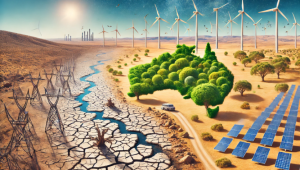Climate change significantly affects Australia, with its economic implications being a prominent concern for policymakers and businesses. These impacts, while challenging, present unique opportunities for green investment, offering a pathway to mitigate risks and foster sustainable growth.
Green investment thus becomes a pivotal focus for transforming these challenges into prospects for innovation and resilience. The nation’s ecosystem and economy are intricately linked, making it vulnerable to the adverse effects of climate change.
Rising temperatures, extreme weather events, and increasing frequency of natural disasters are altering landscapes and impacting industries, from agriculture to tourism. These changes demand urgent attention and adaptation to safeguard long-term economic stability.
Understanding economic challenges

Australia faces numerous economic challenges resulting from its changing climate. These challenges range from direct impacts, such as damage to infrastructure due to extreme weather, to indirect consequences, like shifts in global market dynamics.
The agricultural sector, a cornerstone of the Australian economy, is particularly vulnerable, confronting issues like droughts and unpredictable weather patterns that affect crop yields and livestock. Additionally, rising insurance costs associated with increased natural disasters pose financial burdens on businesses and individuals alike.
These escalating costs highlight the urgency of implementing strategies that not only mitigate risks but also promote environmental wellbeing. Transitioning to greener practices is an inevitable economic step, offering a proactive approach to addressing these issues while fostering new industries and job opportunities.
Sector-specific impacts
The Australian economy is diverse, with various sectors feeling the impacts of climate alterations uniquely. The energy sector, traditionally reliant on fossil fuels, faces immense pressure to decarbonise as international climate commitments intensify.
This transformation offers Australia the chance to lead in renewable energy, drawing from abundant solar and wind resources. Water security is another critical concern, with changing rainfall patterns impacting supply.
Urban and agricultural water demands necessitate innovative solutions, such as investments in water recycling and efficiency technologies. By prioritising sustainable water management, Australia can mitigate future scarcity and ensure economic activities continue unimpeded.
The financial sector plays a pivotal role in facilitating this transition by directing funds towards sustainable projects. Financial institutions are increasingly recognising the importance of green portfolio diversification, providing capital for initiatives that align with climate objectives.
This shift in investment trends reflects a broader understanding of sustainability as both a necessity and a profitable endeavour, encouraging further exploration of green finance opportunities.
Social and economic intersections
The socioeconomic impacts of climate change cannot be overlooked, as they often exacerbate existing inequalities. Vulnerable communities frequently bear the brunt of climatic shifts, with economic challenges intensifying for those lacking resources to adapt. Investing in social infrastructure that enhances resilience is vital, ensuring that all Australians can manage and recover from climatic adversities.
Moreover, empowering communities through education and training for green jobs can facilitate a just transition, ensuring that economic shifts benefit a broad spectrum of the population. This includes retraining workers from traditional industries to partake in emerging green sectors, thus promoting inclusivity in economic growth.
Exploring opportunities for green investment
Understanding the potential for sustainable investments requires a shift in perspective, viewing climate challenges as catalysts for innovation rather than insurmountable obstacles. Each challenge presents a unique opportunity for green investment, from renewable energy and water management to sustainable agriculture and conservation.
Renewable energy, notably solar and wind, offers substantial investment potential, given Australia’s natural advantages and growing global demand for clean energy solutions. Advancements in energy storage and grid technologies can enhance energy reliability, supporting economic growth while reducing dependency on traditional energy sources.
Technological innovations
Technological advancements are crucial in driving the transition towards a sustainable economy. Innovations in fields such as smart grids, carbon capture, and artificial intelligence offer pathways to manage resources more efficiently and reduce emissions. By fostering tech-driven solutions, Australia can enhance its competitive edge in the global green market.
The startup ecosystem plays a vital role in this transformation, with numerous Australian startups at the forefront of developing sustainable technologies. Supporting innovation through investment and policy initiatives can accelerate their growth and integration into the mainstream economy, offering new opportunities for job creation and industry leadership.
Such technological developments also intersect with the digital economy, enabling smarter energy management and efficient infrastructure networks. The integration of digital technologies with sustainable practices presents a holistic model for economic development, combining environmental stewardship with modern economic frameworks.
Policy and incentive structures
Policy frameworks and incentives play a crucial role in facilitating green investments. The Australian government has the opportunity to enact policies that encourage sustainable practices, supporting businesses and individuals transitioning towards a green economy.
Tax incentives, subsidies for renewable energy installations, and grants for research and development are examples of how policy can drive investment. Regulatory clarity and long-term commitments are essential for instilling investor confidence in green projects.
Clear guidelines and consistent policies enable investors to plan with certainty, recognising the benefits of aligning their portfolios with sustainable objectives. Collaborative efforts between government, industry, and research institutions can amplify the effectiveness of these initiatives, creating a cohesive environment for green investment growth.



